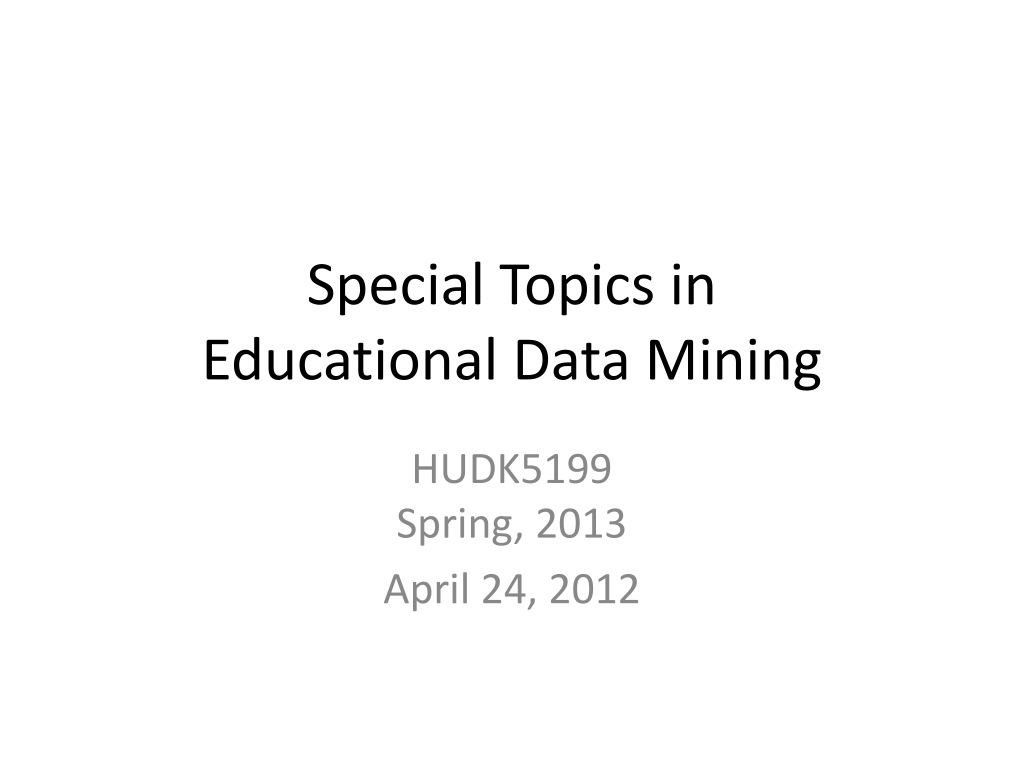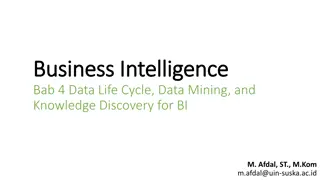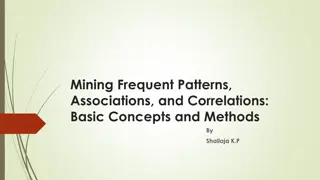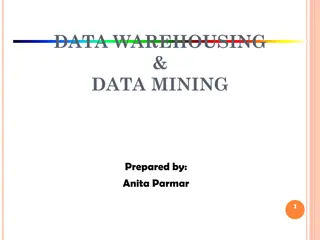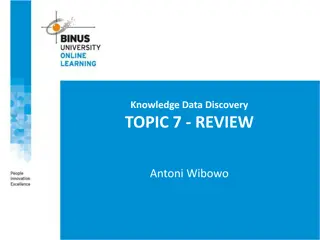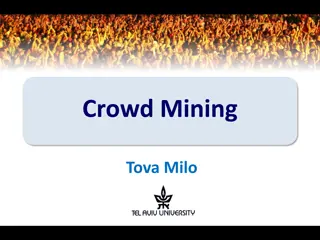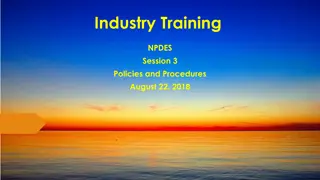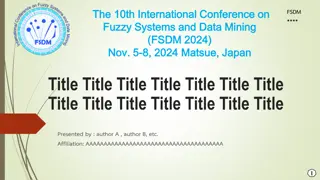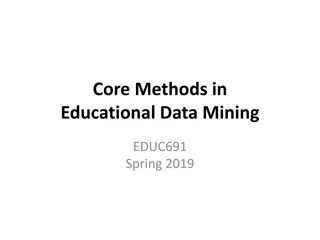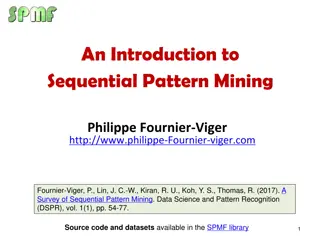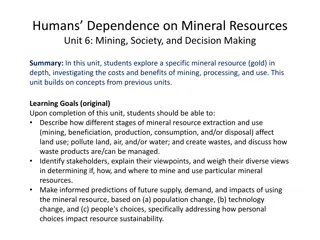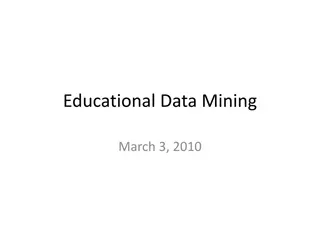Exploring Special Topics in Educational Data Mining
Delve into the world of Sequential Pattern Mining and Association Rule Mining in educational data analysis. Learn about the two categories of SPM approaches, ARM examples like diaper-beer purchases, and SPM examples such as customer behavior patterns. Discover how these methods extract valuable insights from educational datasets through temporal and rule-based analyses.
Download Presentation

Please find below an Image/Link to download the presentation.
The content on the website is provided AS IS for your information and personal use only. It may not be sold, licensed, or shared on other websites without obtaining consent from the author. Download presentation by click this link. If you encounter any issues during the download, it is possible that the publisher has removed the file from their server.
E N D
Presentation Transcript
Special Topics in Educational Data Mining HUDK5199 Spring, 2013 April 24, 2012
Todays Class Sequential Pattern Mining
Two categories of SPM (That we ll discuss today) Approaches Coming from Association Rule Mining MOTIF Extraction
Association Rule Mining Try to automatically find if-then rules within the data set
Sequential Pattern Mining Try to automatically find temporal patterns within the data set
ARM Example If person X buys diapers, Person X buys beer Purchases occur at the same time
SPM Example If person X buys novel Foundation now, Person X buys novel Second Foundation in a later transaction Conclusion: recommend Second Foundation to people who have previously purchased Foundation
SPM Example Many customers rent Star Wars, then the Empire Strikes Back, then Return of the Jedi Doesn t matter if they rent other stuff in- between
SPM Example Many customers buy flowers, and then buy diapers AND diaper cream several months later
SPM Example Many learners become confused, then game the system, then become frustrated, then complete gaming the system, then become re- engaged
Different Constraints than ARM If-then elements do not need to occur in the same data point Instead If-then elements should have same user (or other organizing variable) If elements can be within a certain time window of each other Then element time should be within a certain window after if times
Sequential Pattern Mining Find all subsequences in data with high support Support calculated as number of sequences that contain subsequence, divided by total number of sequences
Sequential Pattern Mining What are some subsequences with high support? (What is their support?) Chuck: a, abc, ac, de, cef Darlene: af, ab, acd, dabc, ef Egoberto: aef, ab, aceh, d, ae Francine: a, bc, acf, d, abeg
GSP (Generalized Sequential Pattern) Classic Algorithm (Srikant & Agrawal, 1996)
Data pre-processing Data transformed from individual actions to sequences by user E.g. Bob: {GAMING and BORED, OFF-TASK and BORED, ON-TASK and BORED, GAMING and BORED, GAMING and FRUSTRATED, ON-TASK and BORED}
Data pre-processing In some cases, time also included E.g. Bob: {GAMING and BORED 5:05:20, OFF-TASK and BORED 5:05:40, ON-TASK and BORED 5:06:00, GAMING and BORED 5:06:20, GAMING and FRUSTRATED 5:06:40, ON-TASK and BORED 5:07:00}
Algorithm Take the whole set of sequences of length 1 May include ANDed combinations at same time Find which sequences of length 1 have support over pre-chosen threshold Compose potential sequences out of pairs of sequences of length 1 with acceptable support Find which sequences of length 2 have support over pre-chosen threshold Compose potential sequences out of triplets of sequences of length 1 and 2 with acceptable support Continue until no new sequences found
Lets execute GPS algorithm With min support = 50%
Lets execute GPS algorithm With min support = 50% Chuck: a, abc, ac, de, cef Darlene: af, ab, acd, dabc, ef Egoberto: aef, ab, aceh, d, ae Francine: a, bc, acf, d, abeg
Other algorithms Free-Span Prefix-Span Select sub-sets of data to search within Faster, but same basic idea as in GPS
Perera et al. (2009) What were the three ways that Perera et al. (2009) used sequential pattern mining? What did they learn, and how did they use the information?
Perera et al. (2009) 1. Overall uses of collaborative tools by groups 2. Sequences of collaborative tool use by different group members 3. Sequences of access of specific resources by different group members In all cases, they found common patterns and then looked at how support differed for successful and unsuccessful groups
Perera et al. (2009): Important Findings 1. Overall uses of collaborative tools by groups Successful groups used ticketing system more than the wiki; weaker groups used wiki more Patterns were particularly strong for group leaders
Perera et al. (2009): Important Findings 2. Sequences of collaborative tool use by different group members Successful groups characterized by leader opening ticket and other student working on ticket Successful groups characterized by students other than leader opening ticket, and other students working on ticket
Perera et al. (2009): Important Findings 3. Sequences of access of specific resources by different group members The best groups had interactions around the same resource by multiple students The poor groups did no work on tickets before closing them
Motif Short, recurring pattern in a sequence of categories occurring over time
Motif in Music Short, recurring pattern of notes in a musical composition
Motif in Music What s the motif? http://www.youtube.com/watch?v=rRgXUFnf KIY How many times does the motif occur?
Motif in Music What s the motif? http://www.youtube.com/watch?v=rRgXUFnf KIY How many times does the motif occur? Depends on how you define it, right? And that s part of the challenge
Motif in Language Short, recurring pattern of characters in a sequence of characters occurring over time
Motif in Genetics Short, recurring pattern of genes in a sequence of genes occurring over time Typically written as letters
Goal of Motif Extraction Discern a common pattern of characters in a large corpus of characters The characters may vary slightly from case to case
Can you find the motif? UBSWWDFKLWPRHUC INUSUNSGDAAICAV XRZZWCDXOVZZJKQ JBDPXBDVEJVMBKK VBDWNLROFVUBFFW OWIFTIENDOXJXIOB AUAAOOXZAABZSBT VOVCROMCJTOLXYU HUVRYFREENDOBBGC AQJBVXJCAJLEMAU MUAWSNTVZXSFHMI LFQRKUTFRIENDOV ONJORIFCGAUGIRN PJGCHBDQIWJJTMQ LOMTPOQHJVYYMFJ IQYQHKKBNBVDFPV LWGJMVPKYOZNMSA JJLHWPZAYZIGGEH RUPMFOHPVSPPVPT BAZXVFTPQFQJVBM IGJZRMAAWJBESSS JXZFRIEMDOVZRBJY HLPMOKUOXGRIENDO IRPWYIRJISLFVFF
How would you describe the motif? UBSWWDFKLWPRHUC INUSUNSGDAAICAV XRZZWCDXOVZZJKQ JBDPXBDVEJVMBKK VBDWNLROFVUBFFW OWIFTIENDOXJXIOB AUAAOOXZAABZSBT VOVCROMCJTOLXYU HUVRYFREENDOBBGC AQJBVXJCAJLEMAU MUAWSNTVZXSFHMI LFQRKUTFRIENDOV ONJORIFCGAUGIRN PJGCHBDQIWJJTMQ LOMTPOQHJVYYMFJ IQYQHKKBNBVDFPV LWGJMVPKYOZNMSA JJLHWPZAYZIGGEH RUPMFOHPVSPPVPT BAZXVFTPQFQJVBM IGJZRMAAWJBESSS JXZFRIEMDOVZRBJY HLPMOKUOXGRIENDO IRPWYIRJISLFVFF
Finding motifs Several algorithms
Finding motifs Variant on PROJECTION algorithm (Tompa & Buhler, 2001) used in (Shanabrook et al., 2010) Only example of motif extraction in educational data mining so far
Big idea For each character string C that could be a motif example (e.g. all character strings of desired length) Create a set of projections, random variations of C that vary in one or more ways
Big idea For each pair of strings C1 and C2, see how many overlaps there are between their projection matrices Take the pair with the most matches and combine into a motif Creating multi-example motif if 3+ get added together Repeat until goal number of motifs is found, or until new motif is below criterion goodness
Motif in Education Short, recurring pattern of behaviors in a sequence of behaviors occurring over time Written as letters in Shanabrook et al. (2010)
Detail for education How do you segment student behavior? Could use student s interaction on an entire problem, and compute letters across whole problem Might make more sense in tutors with shorter problems Could use student s interaction on an entire problem, and define letters differently for context within whole problem Approach used by Shanabrook et al. (2010) Could use sliding window of N actions
Behaviors in Shanabrook et al. hints (a, b, c) Hints is a measure of the number of hints viewed for this problem. Although each problem has a maximum number of hints, the hint count does not have an upper bound because students can repeat hints and the count will increase at each repeated view. The three categories for hints are: (a) no hints, meaning that thestudent did not use the hint facility for that problem, (b) meaning the student used the hint facility, but was not given the solution, and (c) last hint solved, meaning that the student was given the solution to the problem by the last hint. As described above, this metric combines two values logged by the tutor: the count of hints seen, and an indicator that the final hint giving the answer was seen. The data could have been simply binned low, medium, high hints; however, this would have missed the significance of zero hints and using hints to reveal the problem solution.
Behaviors in Shanabrook et al. secFirst (d, e, f) The seconds to first attempt is an important measure as it is during this time that the student is reading the problem and formulating their response. In previous research [6], five seconds was determined to be a threshold for this metric representing gaming: students who make a first attempt in less than five seconds are considered not working on-task. We divide secFirst into three bins: (d) less than 5 sec, (e) 5 to 30 sec, (f) greater than 30 sec. (d) represents students who are gaming the system, (e) represents a moderate time to the first attempt, (f) represents a long time to the first attempt. The cut at 30 seconds was chosen because it equalizes the distribution of bins (e and f), representing a division between a moderate and a long time to the first attempt.
Behaviors in Shanabrook et al. secOther (g, h, i, j, k) This variable represents actions related to answering the problem after the first attempt was made. While the first attempt includes the problem reading and solution time, subsequent solution attempts could be much quicker and the student could still be making good effort. secOther is categorized in five bins: (g) skip, (h) solved on first, (i) 0 to 1.2 sec, (j) 1.2 to 2.9 sec, (k) greater than 2.9 sec. First, there are two categorical bins, skip and solve on first attempt. These are each determined from an indicator in the log data for that problem. Skipping a problem implies only that students never clicked on a correct answer; they could have worked on the problem and then given up, or immediately skipped to the next problem with only a quick look. Solved on first attempt indicates correctly solving the problem. If neither of the first two bins are indicated in the logs, then the secOther metric measures the mean time for all attempts after the first. The divisions of 1.2 sec and 2.9 sec for the latter three bins were obtained using the mean and one standard deviation above the mean for all tutor usage; (i) less than 1.2 seconds would indicate guessing, (j) would indicate normal attempts, and (k) would indicate a long time between attempts.
Behaviors in Shanabrook et al. numIncorrect (o, p, q) - Each problem has four or five possible answer choices, that we divide into three groups: (o) zero incorrect attempts, indicates either solved on first attempt, skipped problem, or last hint solves problem (defined by the other metrics); (p) indicates choosing the correct answer in the second or third attempt, and (q) obtaining the answer by default in a four answer problem or possibly guessing when there is five answer problem.
